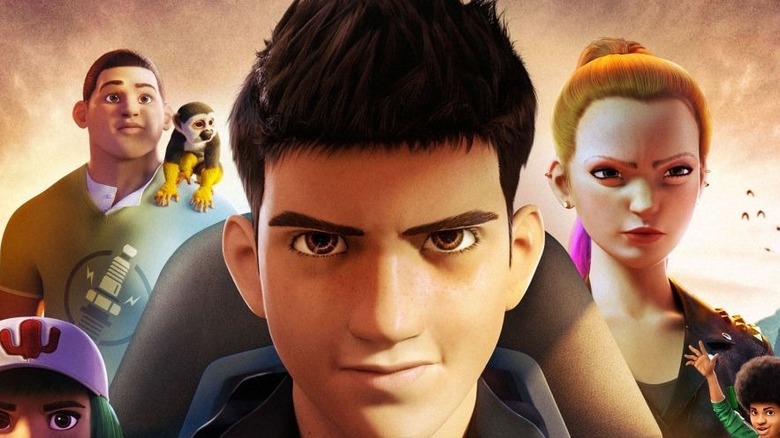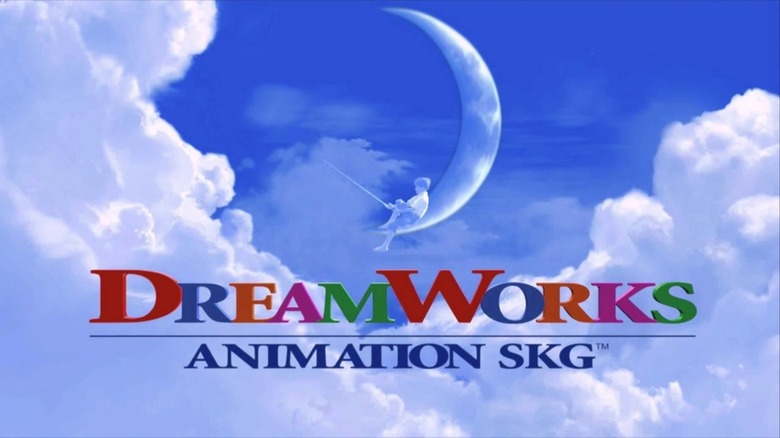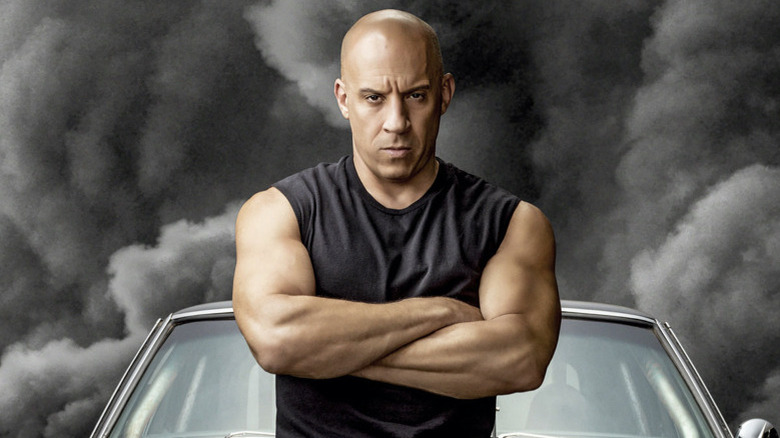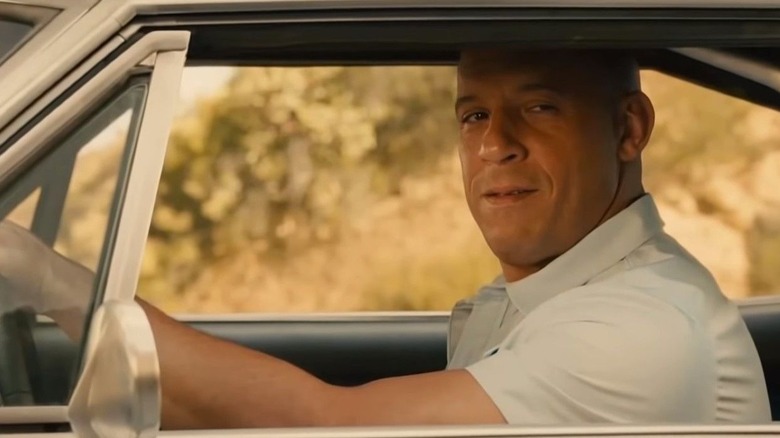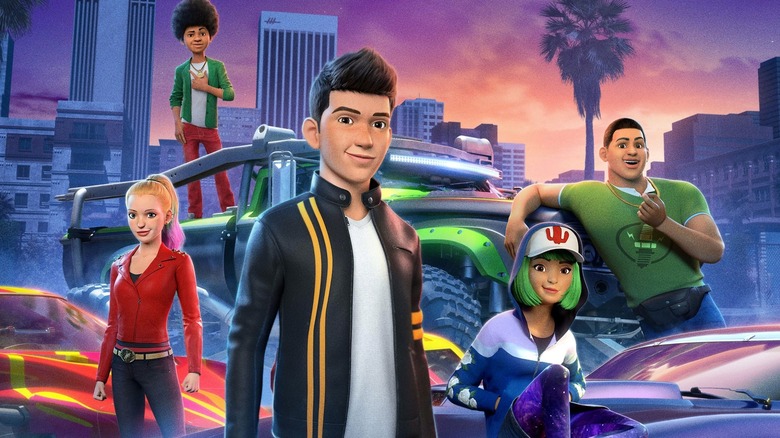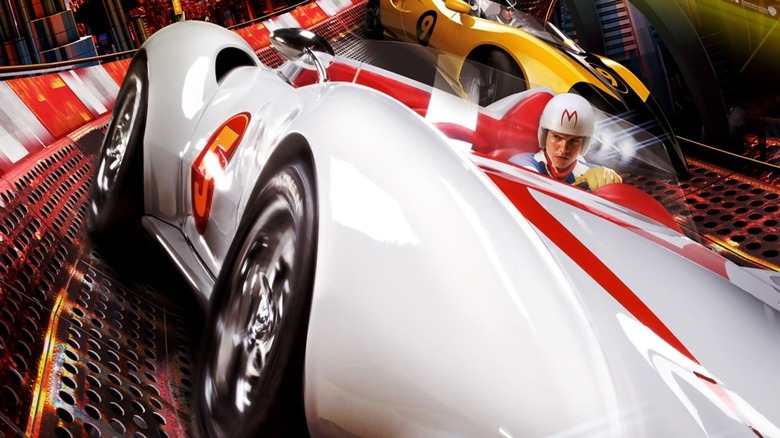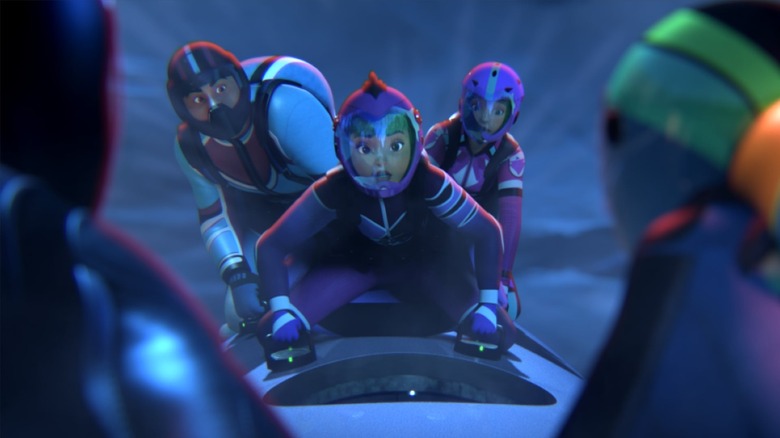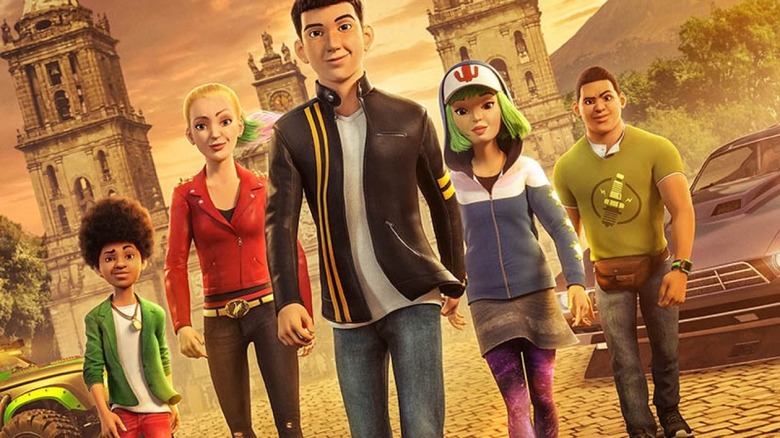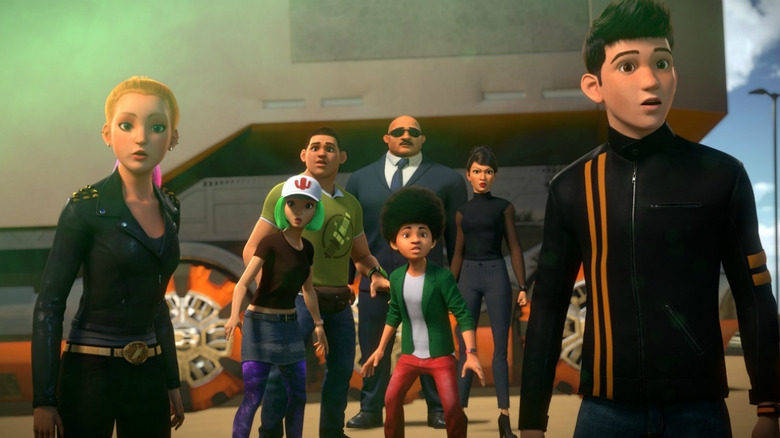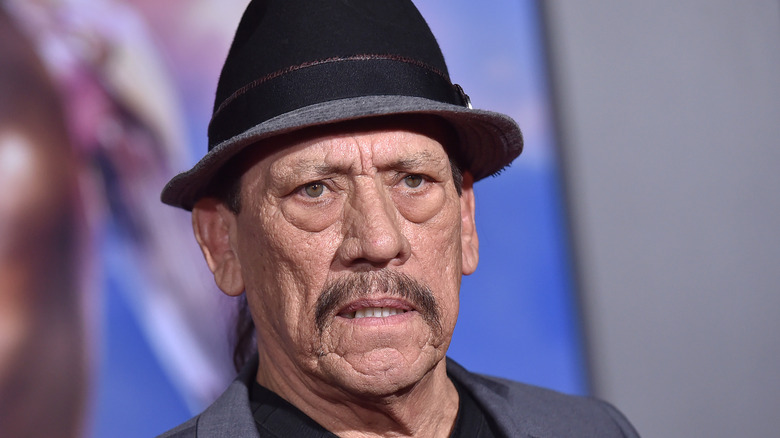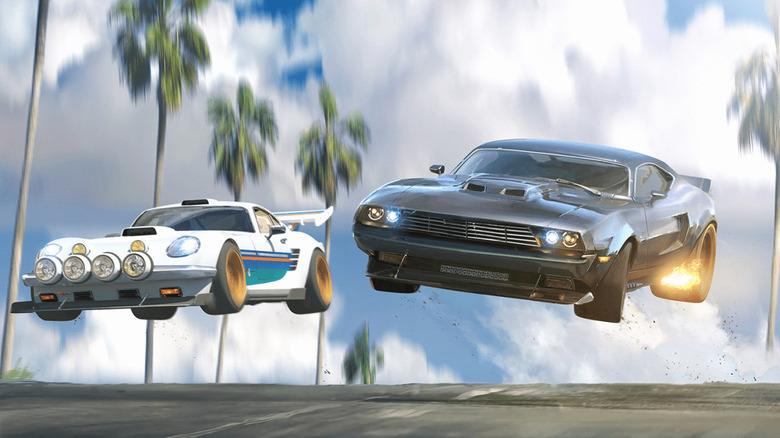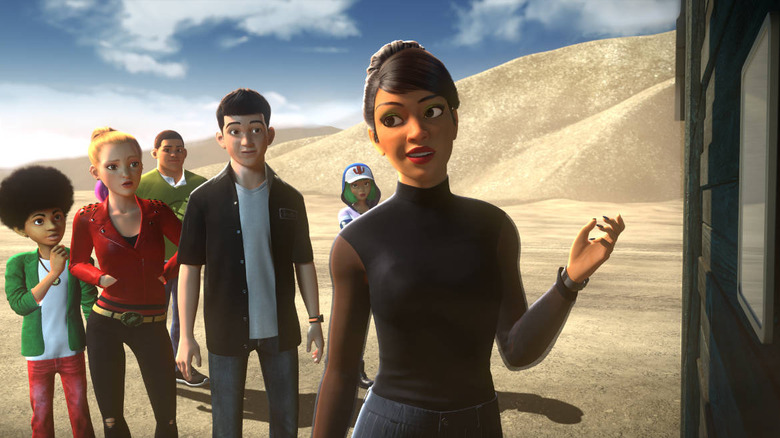The Untold Truth About Fast & Furious: Spy Racers
In December 2019, "Fast & Furious" fans met Tony Toretto (Tyler Posey), the cousin of Vin Diesel's Dominic Toretto and the protagonist of "Fast & Furious: Spy Racers." In this kid-oriented cartoon, Toretto got to lead his own group, comprised of teenagers, who would carry out automobile-related missions to stop evildoers.
"Spy Racers" has already carved out four seasons on Netflix, taking the principal characters everywhere from Rio de Janeiro to the Sahara Desert to Mexico. The expansive locales of the show further the "Fast & Furious" films' depiction of adventures all across the globe, and this combined with other similar elements would make it easy to assume all of "Spy Racers" is just a retread of the "Fast & Furious" flicks.
However, there are many underappreciated aspects of the show that reflect more creativity, diligence and hard work than you might expect. Beneath the hood of "Spy Racers" is an engine worth taking apart, because there are some interesting elements to the adventures of Tony Toretto.
Universal's purchase of DreamWorks influenced the show's creation
The modern "Fast and the Furious" franchise has existed since 2001 (borrowing its name from an unrelated 1954 Roger Corman film), getting an extra boost of pop culture NOS with the dynamite box office success of "Fast & Furious" in 2009. Since the series began churning out these movies, audiences have been able to experience v
Given the ubiquity of Dominic Toretto and his family, you wonder why it took nearly two decades for a kids-oriented cartoon extension of the mythos to emerge; then again, these are movies that, even though rated PG-13, get as close to the R threshold as they can without crossing it. As it turns out, the impetus to finally drive down the cartoon road came from series distributor Universal Pictures.
In 2016, this studio acquired DreamWorks Animation, which opened up new possibilities for what Universal could do to expand on properties like "Fast & Furious." "It all started when Universal bought DreamWorks," explained "Spy Racers" executive producer Tim Hedrick in 2020. "They were very interested in getting into Fast & Furious and Jurassic (Park). Those were the two big properties that I think they thought would be really cool to explore for kids." Thanks to this corporate merger, the "Fast & Furious" could finally have its very own equivalent to "The Real Ghostbusters."
"Spy Racers" was required to feature the Toretto family
For anyone crafting a new property within an established franchise, it's inevitable there will be strict rules to follow. After all, this is a creative sandbox that a lot of artists are playing in across multiple movies and TV shows, so there's no need for one writer or director to hog all the toys. This was true for the creators of "Spy Racers," who were given a specific handful of rules to follow as they blueprinted the first-ever TV show in this universe.
According to executive producer Hedrick, though, the rules weren't suffocating on a creative level. "[I] never really had a lot of guidelines coming in other than they wanted it to feature some part of the Toretto family," he said of the creation of the show. "Which totally makes sense, because 'Fast & Furious' is all about family. Other than that, it was pretty wide open. I really wanted to come in and try to create a show that could stand on its own."
That didn't mean, however, that participants of prior "Fast & Furious" installments didn't have an influence on "Spy Racers." "It's a gigantic franchise and it has to go through so many people who have been involved with it for so long," Hedrick added. "All the producers and writers, Vin Diesel, and everybody has to sign off on it."
Vin Diesel wanted the show to appeal to kids
Any "Fast & Furious" property will inevitably involve the presence of Vin Diesel. The man behind Dominic Toretto has starred in all but two installments of the "Fast & Furious" movies and it's no surprise to hear that he had a say in how "Fast & Furious: Spy Racers" turned out. However, his primary directive to the folks running this cartoon wasn't to emphasize obscure bits of "Fast & Furious" lore or to set up future installments. Rather, Diesel's main point of emphasis was to make something entertaining for the target audience of "Spy Racers."
"[Diesel] was really interested and he wanted to make sure that the show was going to be appropriate for kids," executive producer Tim Hedrick said. "I think that was his main concern was that it wasn't just like the movies and so adult that it wouldn't be a show that his kids could watch because he has kids." It's a good thing Diesel realized the importance of this show resonating with youngsters given the kind of movies "Spy Racers" was an extension of. With rampant violence, Corona sipping and scantily-clad ladies a-plenty, the "Fast & Furious" movies haven't always been super kid-friendly. Luckily, Diesel recognized this and clearly wanted that to change when it came time to talk with "Fast & Furious: Spy Racers."
This show is very careful about its homages
While "Spy Racers" is firmly set within the universe of "Fast & Furious," and even incorporates characters and locations from the movies, it's also something that's supposed to stand on its own two feet. With that in mind, the creators of this program have been insistent that the show be more than just a rerun of the movies.
"It's kind of piece-by-piece how we do it," Hedrick has said of the process.
In terms of how "Spy Racers" references "Fast & Furious" lore, he added: "I love the movies and obviously that's what we're building on so there's a lot to hit. But we always try to bring a new, fresh take to it. I don't want to just be ripping off things that you saw in the films and putting them right in the show."
Hedrick also noted that the crew tries to add a sense of uniqueness to the movie references by using animation to realize these moments in a more "heightened" fashion than would be possible in the confines of live-action storytelling. Then again, when the live-action movies have cars leaping between sky scrapers, all bets are off.
"We want our world to be a little bit bigger," Hedrick explained regarding how "Spy Racers" tries to differentiate itself from its cinematic predecessors. "[It's] a little more colorful, the cars have rockets and everything is just pushed a little bit further."
The "Speed Racer" movie was an influence
"Fast & Furious" is not the only influence that fuels "Spy Racers." Classic cartoons have also been a guiding light for the program, including one particular anime that has had a sizable impact on pop culture for decades now.
Long before the 2008 movie, "Speed Racer" began leaving tracks all over various artistic endeavors following its influential 1960s television run. The franchise's ongoing impact on pop culture can be seen all over the antics of "Spy Racers," with obvious parallels between the two kid-skewing cartoons about people driving really fast, loaded-to-the-gills-with-weaponry cars.
"It definitely came up," Tim Hedrick said when asked about how "Speed Racer" influenced "Spy Racers." "How could there not be? 'Speed Racer' was awesome ... there's so many anime where this kind of racing show has lived up until now. So you're going to have to pull some of those references."
This influence isn't only seen in the sequences where animated cars zoom by the camera at maximum speed. "Spy Racers" provides another tip of the hat as well, this time to "Speed Racer" primate sidekick Chim-Chim. In its third season, "Spy Racer" introduced its own monkey character, Donut.
Netlfix controls when the show comes out
There are a lot of cooks in the kitchen when it comes to making "Spy Racers." As mentioned before, the "Fast & Furious" property belongs to Universal, the show is created and run by DreamWorks Animation, and it is released by Netflix. On top of that, there are assorted personalities from the original film franchise who have earned producer rights (Vin Diesel, Neal Moritz), and then you get into the 5 credited directors and 14 credited writers across the life of the series.
In a December 2020 interview, Hedrick shed light on the situation by revealing that it was Netflix that actually controlled the show's release pattern.
"In terms of the release schedule, we all live at the whim of Netflix," Hedrick said. "Which is great! I love that it's coming out sooner, because people never know and [ask] 'Is there going to be more?' So it's great that it's coming out now but when it gets released is in the hands of a higher power."
While the same interview saw Hedrick noting how key "Fast & Furious" creatives like Chris Morgan and Moritz have an influence on the program's storytelling, he's also made it apparent that Netflix, above all others, control when new episodes of "Spy Racers" hit the streets.
The creators wanted to emphasize fun
Sure, the primary goal behind "Spy Racers" is to introduce the franchise to a younger demo, but the series creators insist there is another goal that ranks even higher. According to Hedrick, they just want to make sure the audience has a good time.
"I just wanted it to be fun; it just had to be fun," he explained. "I didn't want to get caught up in gigantic mythology, I didn't want to think how does this fit in with the 'Fast & Furious' legacy. I wanted a family to be able to sit down and enjoy it together. That was the base level. We hit that, and I'm fine ... at the end of the day, I just wanted it to be straight-up entertaining."
Other contemporary cartoons like, say, "Adventure Time" certainly seem to have loftier intentions. But then again, the "Furious" films have never been high-minded Oscar-bait themselves, so it makes sense that "Spy Racers" would similarly aim for fast, full-throated fun above all else.
"Spy Racers" tries to subvert expectations
It's the classic problem for any TV show: How do you keep your program from getting stale?
Some productions end up just repeating the same plotlines over and over again by the time the second season. But such wheel-spinning simply would not do for "Spy Racers," a show connected to a film franchise known for repeatedly raising the bar for automobile mayhem.
Hedrick has assured "Spy Racers" fans that they are always looking to bring fresh creativity to the series. Speaking about the decision to put the show's lead characters and their mentor — mysterious secret agent Ms. Nowhere — on the run in the fourth season, Hedrick said that "We always try to find a way to trigger a new set of adventures that gives our team a new point of view. Seeing this secret agency that Nowhere has committed her life to suddenly turn on her and put her on the run was really exciting."
The positive experience of working with Danny Trejo
Who doesn't love Danny Trejo? This busy character actor, commercial pitchman and taco entrepreneur has appeared in everything from "Breaking Bad" to headlining "Machete" movies to doing voiceover work in cartoons like "Storks." His duties behind the microphone have also included a guest role "Spy Racers," during a season that took the lead characters to Trejo's home country of Mexico, which is also where his animated character Tuco calls home.
Hedrick said he surprised that Trejo ended up lending his talents to "Spy Racers." "He was so great, and I was so excited to get him," Hedrick enthused. "I don't know how the good people at DreamWorks casting make these miracles happen, but it was really exciting to have him come in."
He also made sure to mention that Trejo had strong chemistry with "Spy Racers" cast member Jorge Diaz, describing the "Con Air" veteran as "wonderful to work with."
A lot of thought goes into designing the cars
If you're going to be part of the "Fast & Furious" franchise, you need to show real love towards the automobiles. After all, cars have been the heart and soul of the franchise since the first movie, so "Spy Racers" had to make sure it was delivering on this front.
Hedrick noted that the show had an animation team assembled specifically to ensure these fully-animated vehicles were up to muster.
"We have a pretty awesome team of designers," Hedrick explained. "Many of whom are actual car designers, who went to school to design cars for Mercedes-Benz or whatever and instead work for us drawing new cars ... There's a lot of legitimate engineering that goes into building those CG cars, which is very intricate. I'm not qualified to really comment on it, other than to say, 'Wow, that's cool.' They're very, very talented people."
With such knowledgeable artists working under the hood of "Spy Racers," the show has earned a reputation for consistently delivering chases that wouldn't feel out of place burning rubber in the blockbuster films.
The creators are hopeful for more seasons
In the span of 16 months, "Fast & Furious: Spy Racers" has released four different seasons on Netflix, an astounding production output for any TV show.
Given that there are already three more "Fast & Furious" movies on the horizon, it seems likely that the cartoon is only getting warmed up. This assumption is strengthened when you observe the last DreamWorks Animation show run by Hedrick, "Voltron: Legendary Defender." That Netflix cartoon ran for a whopping eight seasons, spanning some 78 episodes. Since those first four seasons add up to 32 episodes, if Hedrick can make "Spy Racers" last as long as "Voltron," fans of this program should have plenty of new roads to explore in the immediate future.
While no official word has been delivered on further seasons of "Spy Racers," Hedrick is hopeful fans can expect more in the future. On the heels of the fourth season's debut, when asked about the possibility of further seasons, he said: "I'm discussing it constantly. I don't know if anybody's listening, but I'm always up to discuss future seasons."
For now, as we await news on Netflix's decision regarding a fifth season, we'll all just have to follow Vin Diesel's lead and live our lives one quarter mile at a time.
